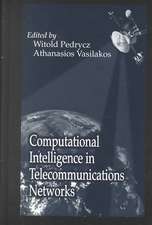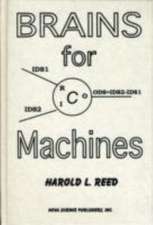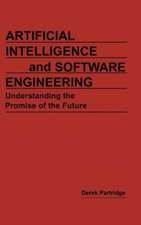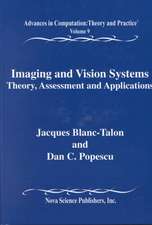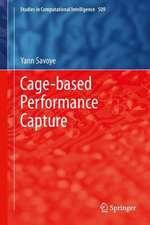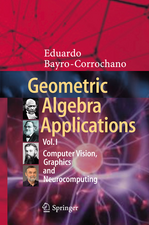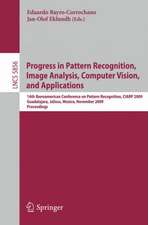Geometric Algebra Applications Vol. II: Robot Modelling and Control
Autor Eduardo Bayro-Corrochanoen Limba Engleză Hardback – 20 iun 2020
general domain of robotics and associated fields using Clifford or geometric alge-
bra. By addressing a wide spectrum of problems in a common language, it offers
both fresh insights and new solutions that are useful to scientists and engineers
working in areas related with robotics.
It introduces non-specialists to Clifford and geometric algebra, and provides ex-
amples to help readers learn how to compute using geometric entities and geomet-
ric formulations. It also includes an in-depth study of applications of Lie group
theory, Lie algebra, spinors and versors and the algebra of incidence using the universal geometric algebra generated by reciprocal null cones.
Featuring a detailed study of kinematics, differential kinematics and dynamics
using geometric algebra, the book also develops Euler Lagrangeand Hamiltoni-
ans equations for dynamics using conformal geometric algebra, and the recursive
Newton-Euler using screw theory in the motor algebra framework. Further, it
comprehensively explores robot modeling and nonlinear controllers, and discusses
several applications in computer vision, graphics, neurocomputing, quantum com-
puting, robotics and control engineering using the geometric algebra framework.
The book also includes over 200 exercises and tips for the development of future
computer software packages for extensive calculations in geometric algebra, and a
entire section focusing on how to write the subroutines in C++, Matlab and Maple
to carry out efficient geometric computations in the geometric algebra framework.
Lastly, it shows how program code can be optimized for real-time computations.
An essential resource for applied physicists, computer scientists, AI researchers,
roboticists and mechanical and electrical engineers, the book clarifies and demon-
strates the importance of geometric computing for building autonomous systems
to advance cognitive systems research.
Preț: 1129.96 lei
Preț vechi: 1378.00 lei
-18% Nou
Puncte Express: 1695
Preț estimativ în valută:
216.23€ • 231.21$ • 180.28£
216.23€ • 231.21$ • 180.28£
Carte tipărită la comandă
Livrare economică 18 aprilie-02 mai
Preluare comenzi: 021 569.72.76
Specificații
ISBN-13: 9783030349769
ISBN-10: 3030349764
Ilustrații: XXIX, 600 p. 256 illus., 167 illus. in color.
Dimensiuni: 155 x 235 mm
Greutate: 1.05 kg
Ediția:1st ed. 2020
Editura: Springer International Publishing
Colecția Springer
Locul publicării:Cham, Switzerland
ISBN-10: 3030349764
Ilustrații: XXIX, 600 p. 256 illus., 167 illus. in color.
Dimensiuni: 155 x 235 mm
Greutate: 1.05 kg
Ediția:1st ed. 2020
Editura: Springer International Publishing
Colecția Springer
Locul publicării:Cham, Switzerland
Cuprins
Geometric Algebra for Modeling in Robotic Physics.- Introduction to Geometric Algebra.- Lie Algebras, Lie Groups and Algebra of Incidence.- 2D, 3D and 4D Geometric Algebras.- Kinematics of the 2D and 3D Spaces.- Conformal Geometric Algebra.- Programming Issues.- Rigid Motion Interpolation.- Robot Kinematics.- Robot Dynamics.- Control of Robot Manipulators.- Robot Neurocontrol.- Robot Control and Tracking.- Rigid Motion Estimation Using Line Observations.- Tracker Endoscope Calibration and Body-Sensors Calibration.- Tracking, Grasping and Object Manipulation.- 3D Maps, Navigation and Relocalization.- Quadrotor.- Modeling and Registration of Medical Data.- Geometric Computing for Minimal Invasive Surgery.
Recenzii
“The book is intended for students and scientists and should be of interest to practicing and research engineers as well of the PhD students in the field of robot modeling and control.” (Clementina Mladenova, zbMATH 1471.93001, 2021)
Textul de pe ultima copertă
The goal of Geometric Algebra Applications Vol. II: Robot Modeling and Control is to present a unified mathematical treatment of diverse problems in the general domain of robotics and associated fields using Clifford, or geometric algebra. By treating a wide spectrum of problems in a common language, this Volume II offers both new insights and new solutions that should be useful to scientists, and engineers working in different areas related with robotics.
Topics and features
-Introduces a no specialists to Clifford, or geometric, algebra and by examples encourages the reader to learn to compute using geometric entities and geometric formulations.
-A study in depth for applications of Lie group theory, Lie algebra, spinors and versors and the algebra of incidence using the universal geometric algebra generated by reciprocal null cones.
-Includes a thorough study of kinematics, differential kinematics and dynamics using geometric algebra. TheEuler Lagrange and Hamiltonians equations for dynamics are developed using conformal geometric algebra and the recursive Newton-Euler using screw theory in the motor algebra framework. A thorough study of robot modeling and nonlinear controllers.
-Thorough discussion of several applications in computer vision, graphics, neurocomputing, quantum computing, robotics and control engineering using the geometric algebra framework.
-209 exercises and hints for the development of future computer software packages for extensive calculations in geometric algebra. A entire section is dedicated to explain how one should write the subroutines in C++, Matlab and Maple to carry out efficient geometric computations in the geometric algebra framework. Furthermore it is shown how program code can be optimized for real time computations.
-The book is an essential resource for applied physicists, computer scientists, AI researchers, roboticists and mechanical and electrical engineers, it clarifies and demonstrates the importance of geometric computing for building autonomous systems and push forward advances in cognitive systems research.
-Introduces a no specialists to Clifford, or geometric, algebra and by examples encourages the reader to learn to compute using geometric entities and geometric formulations.
-A study in depth for applications of Lie group theory, Lie algebra, spinors and versors and the algebra of incidence using the universal geometric algebra generated by reciprocal null cones.
-Includes a thorough study of kinematics, differential kinematics and dynamics using geometric algebra. TheEuler Lagrange and Hamiltonians equations for dynamics are developed using conformal geometric algebra and the recursive Newton-Euler using screw theory in the motor algebra framework. A thorough study of robot modeling and nonlinear controllers.
-Thorough discussion of several applications in computer vision, graphics, neurocomputing, quantum computing, robotics and control engineering using the geometric algebra framework.
-209 exercises and hints for the development of future computer software packages for extensive calculations in geometric algebra. A entire section is dedicated to explain how one should write the subroutines in C++, Matlab and Maple to carry out efficient geometric computations in the geometric algebra framework. Furthermore it is shown how program code can be optimized for real time computations.
-The book is an essential resource for applied physicists, computer scientists, AI researchers, roboticists and mechanical and electrical engineers, it clarifies and demonstrates the importance of geometric computing for building autonomous systems and push forward advances in cognitive systems research.
Caracteristici
Offers in a compact and complete way the theory and methods to apply Geometric Algebra to Robotics Introduces the basics of geometric algebra to specialists and non- specialists in a gentle and comprehensive manner using examples and abundant figures and simulation results Step by step using examples encourages readers to learn how to model, design algorithms for modern applications in the area of robotics



